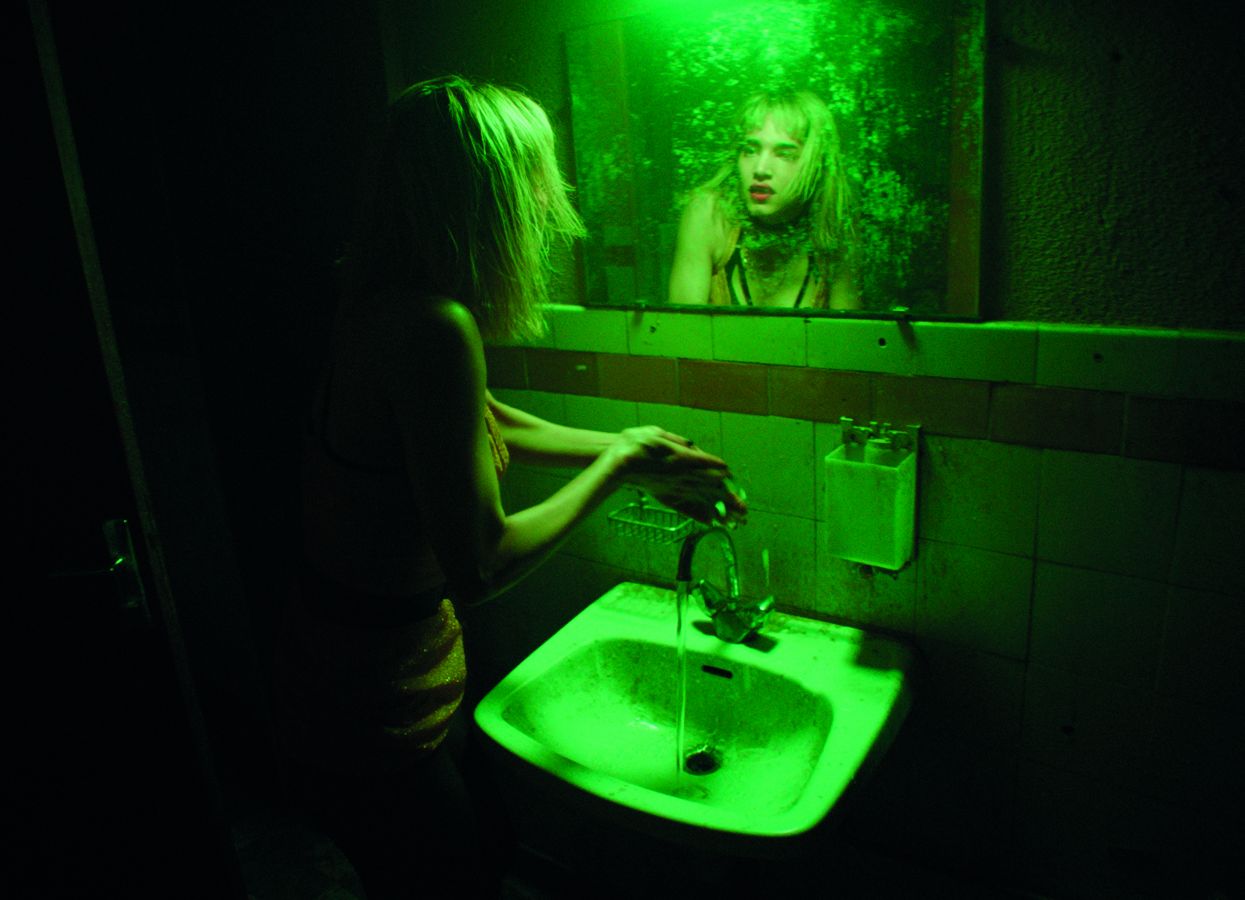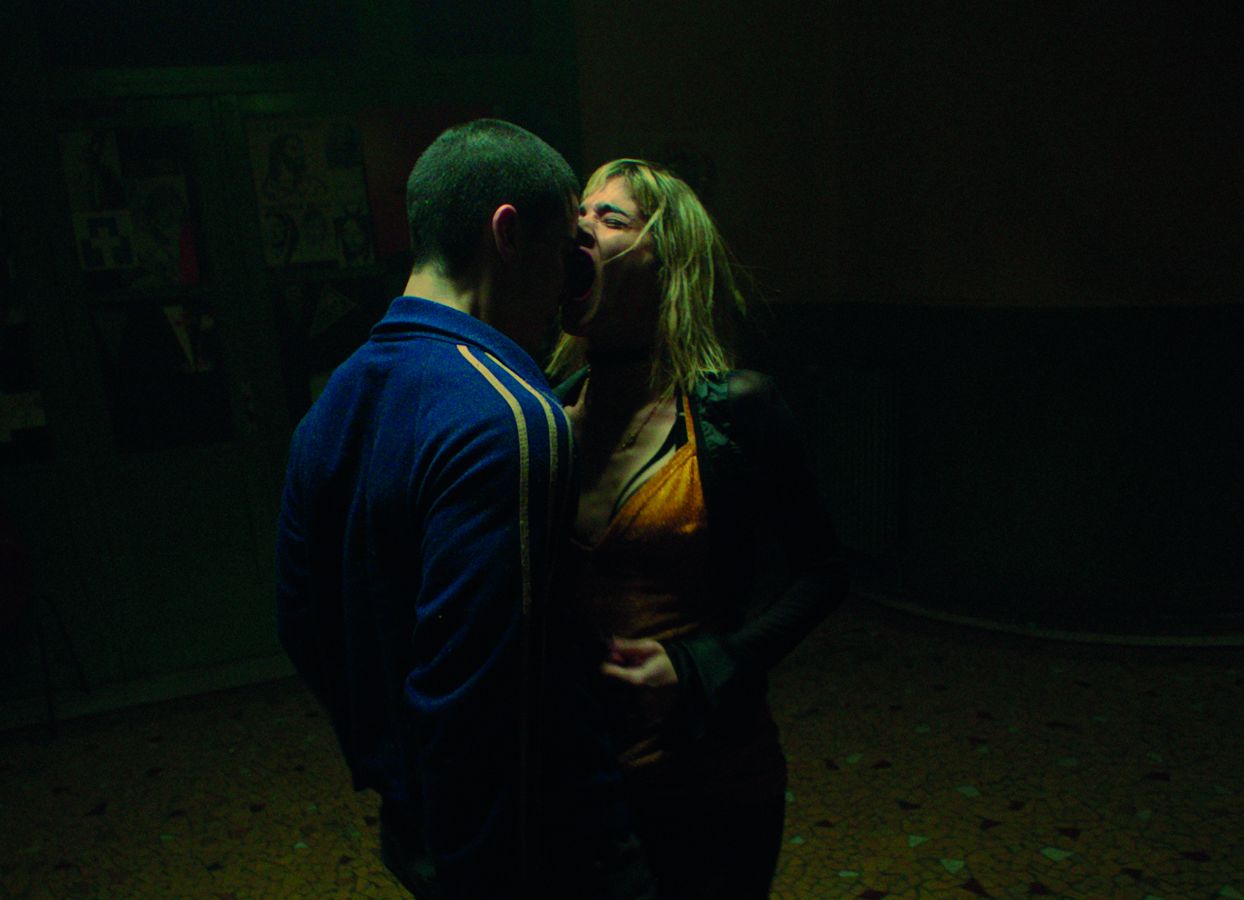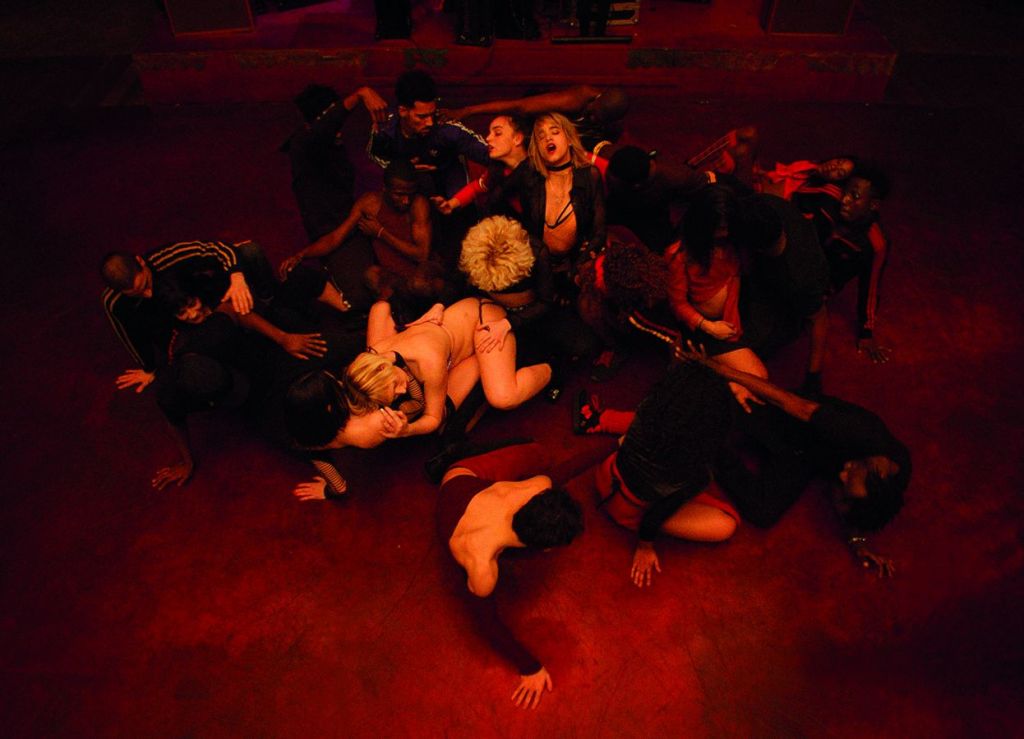This article contains spoilers for Climax and The House That Jack Built.
With his formally bold, often violent and drug-fueled movies, the Argentinian filmmaker Gaspar Noé has been shocking cinemagoers for years. Following the traumatizing Irréversible (2002), the trippy Enter The Void (2009), and the daringly explicit Love (2015), this year sees his return to the Cannes Film Festival with Climax. Co-produced and co-financed by Vice Studios, the film is a techno musical set entirely at a dance rehearsal space in Paris. Shot in 15 days, Climax sees an assortment of real-life dancers losing their minds over the course of the film due to a mysteriously-spiked sangria. What begins as a fun trip quickly descends into a surreal and exhilarating cautionary tale.
Videos by VICE
VICE talked to Noé at Cannes, where the film recently screened in the Quinzaine des Realisateurs (“Directors’ Fortnight”) section, and won Noé the Art Cinema Award, the top prize in the section. During our conversation, the director talked about his love of dance, the dangers of drugs and alcohol, and his refusal to do what is expected of him.
VICE: How did you get the idea for the film?
Gaspar Noé: It was a bit like for Irréversible. Sometimes you set up a lot of different projects at once—ideas for a documentary film, for a film about a bad shamanic trip, for not a musical. I can’t stand musicals, but I love dance because it’s a corporeal language that can be so rich and sometimes so unusual. Some dancers, like the ones I’ve filmed, really hypnotize me. I love looking at them. And to make a successful film, you have to love the people you’re filming, so I thought of a film with just dancers and in a context of petty crime. I got the idea at the end of December, and in early January we started preparing the film.
That’s fast!
Yeah, we got it ready in four weeks, we did the casting, and we shot it in 15 days in February. So from A-to-Z, the film was pre-produced, shot, and post-produced in four months.
Is that the fastest feature production you’ve ever done?
Yeah, and today’s technologies allow you to edit the sound and the image so much faster than before. If I had shot the film years ago on film, it would have been a lot different.
Did you do a lot of rehearsals with the dancers?
No, and we got a choreographer that had been recommended by Sofia Boutella but she arrived the Wednesday before shooting, then rehearsed Thursday and Friday with 15 of the 21 dancers. Six more arrived only on Monday morning and she integrated them, and we shot that opening sequence that same night, on that Monday. We had no time, all was done urgently.
Are they professional dancers?
No, they’re kids between 18 to 23 years old and they only do sorts of krump dance-offs or voguing balls! A lot of the dancers were straight, the voguing dancers were mostly gay, so I brought together dancers from different families. At first, the voguers were suspicious. They were like, “What is this film? You’re mixing together krumpers and waackers?” But as soon as the shoot started, they respected each other so much that it made it all the better, since it’s not one style of dancing but several.
That’s what we see in the first sequence, which is so great.
A lot of people have said it’s their favorite sequence, and that they’d never seen that in American dancing.
There were some dance styles that I’d never heard of—I didn’t know krump.
Krump is on the rise. It’s more men that dance it. And waacking is kind of the feminine response to krump. There’s also a dance from France called electro; that was a group of five dancers including the one character called David, played by Romain Guillermic. I had also seen videos of a Congolese contortionist called Snake. We managed to find him through Facebook and we got him a visa and made him come from the Congo. At first I didn’t know how many characters would be coming from foreign countries. I was thinking that maybe half of the dancers would be, but in the end only three are foreigners. And I also thought that there would be more Caucasian girls, because if you go looking into that type of dance, they are rarely white people. It turns out that black and mixed-race people make up more than half of the cast because I picked them according to their talent as dancers, and their sympathy. Some of them were so nice that I was like, “Let’s see what we can improvise together.” I just wanted to film them!

The film is a real showcase for a youth scene that we rarely see in cinema, especially the French youth but also foreign.
Yeah, it’s a bit like the French soccer team! There a very few Caucasians there! But that’s the reality. If you go look for these dancers, most of them live in the banlieues (“suburbs”), have no money, and have those dance battles once per month where they explode. Those are killer! Sometimes they even look like ritual dances, from like Haiti or African countries.
Your camera is so joyous when it is on the dancers.
I did all the camerawork myself! Benoit Debie did the lighting, but I was always carrying the camera running after the dancers! But yeah, a film is like a ghost train: you know nothing bad will happen to you! The first part of the film is like a happy rollercoaster, and then you get to the scary part. Even when I saw Lars von Trier’s film [The House That Jack Built] last night, there were loads of violent sequences but I couldn’t stop laughing—because you just know that it’s a film, and the kids that get shot in the film, they’re not dead! You know that the duckling didn’t actually get his legs cut off! You know that no one got hurt during shooting, and that’s why it’s joyous too. It’d be so awful if it were a documentary!
In this first sequence, the relationship between all the dancers is so idyllic, but as the film goes on, everything breaks down.
Alcohol makes you stupid… Everyone says wine is the blood of Jesus, and maybe it opens up your mind when you have two glasses, but when you have two bottles, most people become stupid. They have blackouts, they become cruel towards everyone, they become aggressive. For me, my worst memories of collective or personal tragedies are all linked to alcohol abuse. Alcohol makes you stupid, stupid, stupid!
And drugs too?
Some drugs make you more stupid than others, but there are some that put you to sleep and others that wake you up. For instance, people who take cocaine become so pretentious, you just want to shove them in a cupboard so that they can look at themselves in a mirror!
There can also be a more political reading of the film, since at the end, it’s the German girl who “wins”…
It’s the Nazi who wins! A tall, blonde, Aryan girl…
It’s a bit strange to see things end badly for these young people who are at first so happy. Do you not have much hope for the youth or for the future of France?
It’s more about human beings, whatever the color of their skin or their nationality. Before being a person, man is an animal, with all its reptilian compulsions. And if at some point you block the conscious part of the mind, you’ve got all the reptilian compulsions that come out. It’s like in [Sam] Peckinpah or [Stanley] Kubrick movies—they start from the idea that the reptilian brain is the strongest of the three brains. You got the hypophysis, which is the reptilian brain. Then you have a second one, the mammalian brain, which is the one that makes you protect your kids and your social group. And then, the neocortex allows you to talk and to plan for the future, to build cathedrals, etc. Alcohol kind of switches off the other two, and all you’ve got left is the reptilian brain, which is about dominance and survival instinct, and therefore about sexuality and reproduction.
You mention Peckinpah, but at the beginning of the film, we see this television surrounded by VHSs of Possession (1981), Suspiria (1977), some other horror films, and some books.
These are all the films and the books I would watch and read about 30 years ago. Some people have told me they recognize my personal collection.
We also recognize motifs from Possession in the film itself.
Yeah, all these films I loved in the 1990s. Possession is a great film, and Romero’s Dawn of the Dead (1978), which all takes place in a closed environment, is a bit like in my film…
What did you tell the actors to prepare them?
I told them not to prepare, but I showed them loads of videos of people under the influence of crack, of LSD, all kinds of drugs, and we made a playlist of those videos of these people completely fucked up and dancing. So for the end of the film, I asked the dancers if they could dance in such a deconstructed or psychotic way. We trained to act crazy!
Since they’re all dancers, I can imagine that they’re very much aware of their bodies.
They are, and they’re also very playful, they love to play.

It’s kinda perfect to have them play people who are high.
Yeah, although I made the mistake, I think on the second day of shooting, of giving them alcohol to wake them up because they were starting to get tired. But afterwards, they were just like drunks who can’t walk straight! So I stopped that very quickly, and we started giving them only coffee and eventually playing some pieces of music that excited them. In the end, the best way to wake them up was to ask Kiddy Smile [who plays “Daddy” in the film] to take the decks for 20 minutes and to make them dance like crazy. After that we were able to shoot for two more hours, then had another break with music that wasn’t related to the film.
That’s reassuring! So there’s a bit of a dichotomy between dance as a way of expression and drugs that destroy that.
It’s one thing to use drugs recreationally, knowingly, with the correct dose, and another thing to have something put in your drink against your will, when you don’t know neither what it is, nor if you’re overdosed. The same thing that can be pleasant can turn nightmarish if it’s a forced experience.
It’s interesting how your films often have drug use and its consequences.
Maybe it’s because I live in Paris and know so many people like that! And in Berlin, it’s even worse. The number of people I know who went to Berlin to be creative because they had funding, and after six months said, “I can’t take it anymore, everyone is high on ketamine, on ecstasy, 24/7!” That’s why it made me laugh that the pretty blonde girl would be from Berlin and that she’d inject drugs through her eyes!
It’s also interesting how in the end, your films often present a rather negative view of drugs, yet when people think about your films, they think of them as amazing trips…
I don’t promote drug abuse—I’m not a crook! With both alcohol and drugs, there’s good and bad, you gotta know how to manage them. The problem is, if it’s you who’s riding the horse, you’re good, but if it’s the horse that’s riding you, your butt hurts!
I love the series of scenes where only two characters talk to each other.
That was totally improvised. One after the other, anytime we had a minute, I was telling the dancers to come and talk about the others for those asides. I asked them to gossip, to say good and bad things about the others, to talk about depression… I was throwing ideas at them and just recording, and because I shot in digital, I could film for 20 or 30 minutes without interruption. After awhile, they were getting more comfortable, and I was telling them to try and be as funny or as cruel as possible, so they had fun improvising on a bunch of topics. Afterwards, I kept the best bits. The one I had the hardest time cutting was between Cyborg and his friend. I had, like, 25 minutes of dialogue, and it was the last thing I edited because everyone was telling me it was too much. Finally I cut out four-fifths of it and it broke my heart! Because it was fucking hilarious!
This conversation is amazing, too, because it’s hard to know how serious they are…
They’re playing the bad guys yet they don’t want to harm anyone!
How did you get the idea to do those asides?
I wanted to introduce those people, because it’s different to introduce yourself in front of a camera for a job in front of the choreographer like at the beginning of the film, and another thing to be a bit comfortable and have the human tensions in the group show. You see there are rivalries, desires, frustrations…
It really makes the film into a snapshot of today’s youth that we rarely see.
Yes, and I liked how the American publications said that it shows that I have a lot of love for all the characters. It’s true! For me, there isn’t one in the bunch that is better than the others. Even the character of Selva, played by Sofia Boutella, has two faces, and you see that she tries her best, she has good intentions, but as soon as alcohol and that mysterious product get to her head, she becomes extremely cruel with the boy who’s supposed to be her lover.
But him too, he’s horrible! And he’s the only white man…
Yeah, and he’s a bit of an extension of all the male characters I’ve had. In Irréversible, you have Vincent Cassel who plays a dude with a shaved head, then in Enter The Void you had another one, and in Love you also have Karl Glusman who played a guy who ran after his dick with his shaved head! I feel like for me, that’s really the prototype of the guy who’s kind of nice but only thinks about his dick…
The film is called Climax, so everyone expected there to be a lot of sex.
Climax isn’t just sex!
But I think that people, after Love, expected something different…
I found that really funny! The word can have a sexual connotation, so people may have expected to see some explicit sex sequences, but it was never gonna be the case at all!
Did you consciously decide to put less sex in this film? Was it in answer to Love ?
You don’t want to make the same film again. Plus, there was an erect penis in I Stand Alone (1998), there were some more in Irréversible, there were some in almost all my films, so that was the main reason. It had diverted the attention so much from Love, too, especially with the American press who was like, “Why did you show a male sex [organ]?” As if there was a difference between the ear of a man and his hand or his dick! You see, I didn’t want the press to once again focus on that alone. But maybe in the next one I’ll put back some sex scenes!
Sign up for our newsletter to get the best of VICE delivered to your inbox daily.
Follow Manuela Lazic on Twitter.




